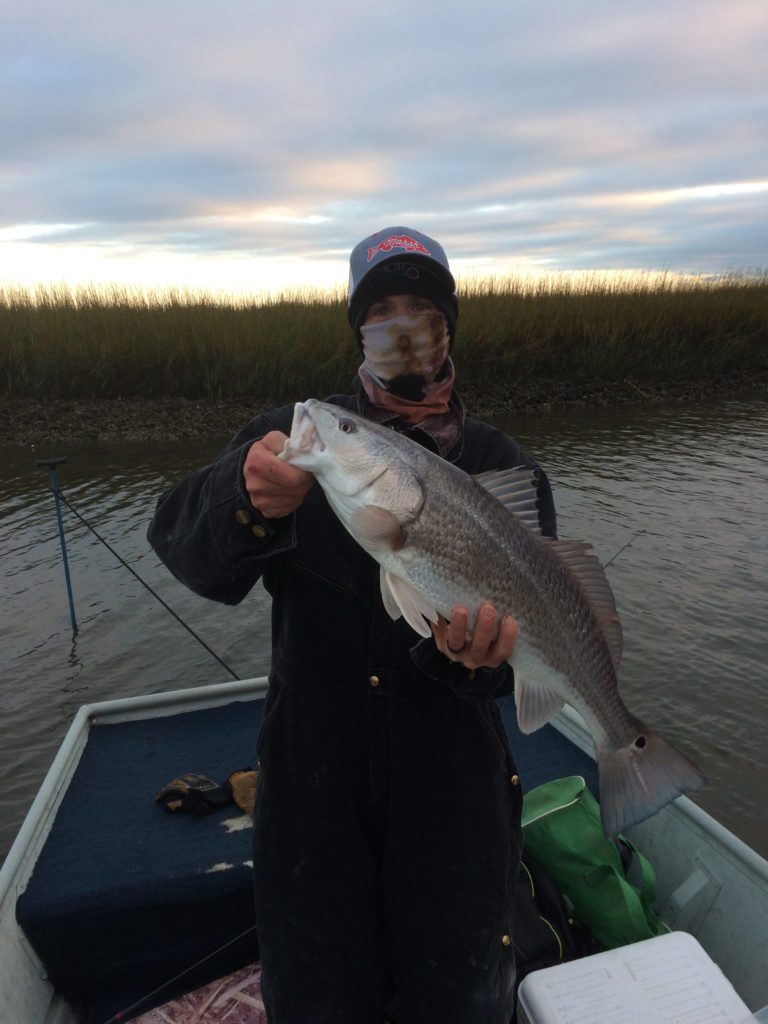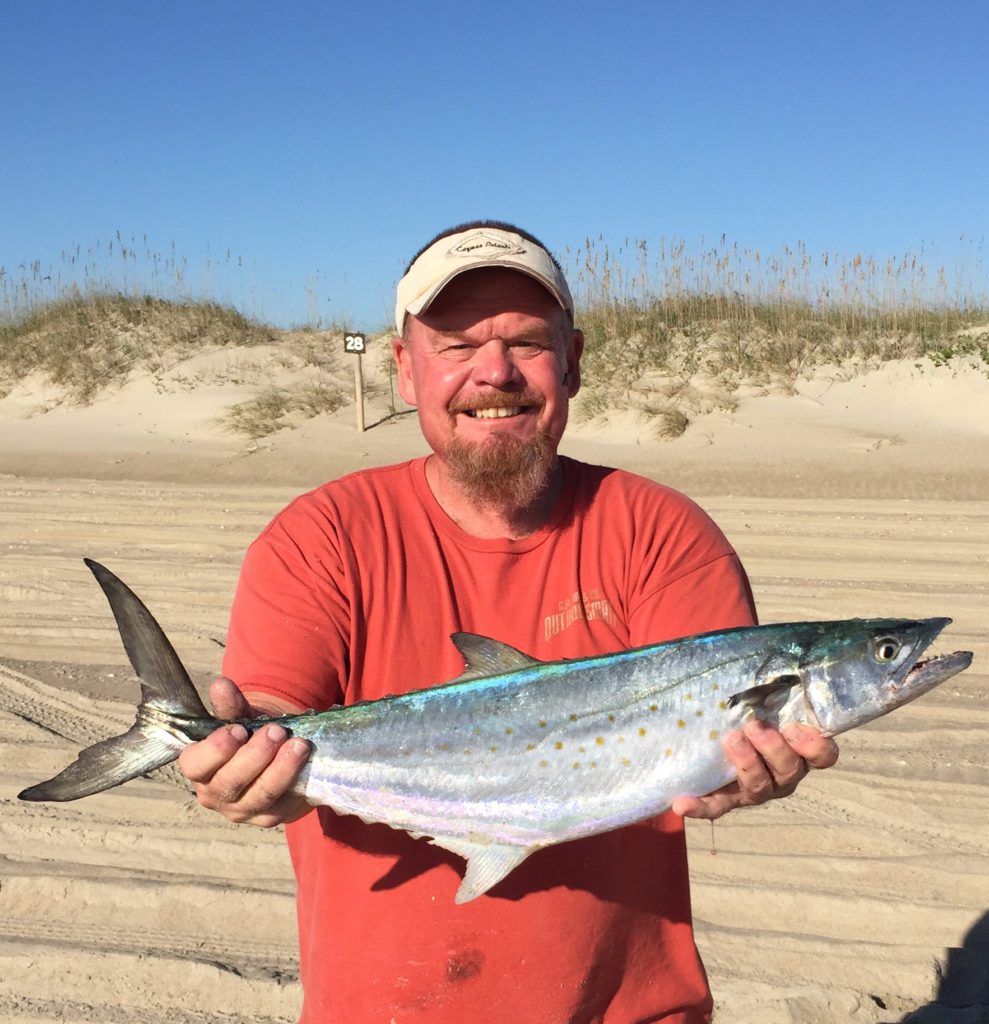Carolina Beach – December 14, 2017
Redd, of Island Tackle and Hardware, reports that speckled trout are holding from the inlet all the way back into the creeks of the Cape Fear River. Anglers in the feeder creeks working marsh edges in 4-6′ of water are having the best luck. Casting MirrOlure MR17s in chicken-on-a-chain color and in the broken glass pattern have worked best. Other colors doing well are the all-white and red head/white body MR17s.
Redfish are also being spotted in creeks and near docks with around 6’ of water. Soft plastics, like new penny Gulp shrimp, are finding the fish.
Another key to finding both redfish and trout is locating the bait. Mud minnows, especially this time of year, are the main diet of both species.
There are still a few sheepshead and black drum being landed around bridges. Both are willing to chew on live or cut shrimp on a Carolina rig.
Nearshore, anglers are running into some smaller groups of bull redfish hanging around the local ARs. Large chunks of cut menhaden or mullet fished on the bottom have been the key to success.
Schools of gray trout holding on local ARs have been willing to bite on Stingsilver jigs.
King mackerel are still off the beach in good numbers around the 10 mile mark. Drone spoons have been the go-to lure.
Out at the Gulf Stream, blackfin tuna, wahoo, sailfish, and a few peanut mahi are still hanging around.
Moving into the rest of the winter, the focus should be on wahoo and blackfin tuna. Wahoo will be at the Stream through March. Pulling large Ilander lures, Pirate plugs, and Yo-Zuri plugs (bonita color) will work best. Blackfin tuna will prefer the smaller Ilanders and Zukers feathers. Both species are hard pressed to turn down these rigs matched with ballyhoo.
In the next couple months, expect the nearshore bottomfish bite to remain strong. Black sea bass will be the main focus in the 10 mile range. They love cut cigar minnows fished close to structure.
Taugtogs will move into the same areas as the black sea bass. Some togs will come in as far as the jetties and even inshore around the bridges. Small pieces of cut shrimp will tempt these tasty fish to feed.
Christian, of Seahawk Fishing Charters, reports an excellent inshore bite on both speckled trout and redfish. The trout are feeding on just about anything as they transition towards the creeks. The best producing setup has been a float rig with a 16” leader and a live shrimp.
As for artificials, MirrOlure MR17s have been a great lure. These suspending lures matched with flash provide a good reaction bite. Another solid option is a 3” Gulp shrimp matched with a 1/4 or 3/16 oz. Wahoo Fishing Products jig head.
Redfish are holding in the same transition areas (towards the creeks). Water in the 2-5′ range with shelly bottoms are holding big numbers of fish. On a nice, sunny day, look for the reds in more open areas around docks and other structure.
The redfish are going to take most of the same lures as the trout. When you have live bait, rigging it on a 1/2 to 3/4 oz. Carolina rig will be key.
Focus on the backs of creeks deeper into winter. Don’t overlook the small feeder creeks either, as they can produce some of the best days. Bends and drop-offs in these creeks are going to hold the fish. They suspend over black mud that heats up the water during sunny days, and then move back into deeper holes when the sun isn’t out.
Luke, of Top Water Guide Co., reports that anglers are seeing great numbers of speckled trout. The majority range from 16-20”. Working MirrOlure MR17s in the broken glass pattern has been a consistent producer. Down South Lures plastics on a 1/4 oz. jig head and topped with a little Pro-Cure bait scent is almost impossible for any of these fish to turn down. As the water continues to cool, it will also clear up. Dropping down leader size to fluorocarbon in the 10-15 lb. range can be very helpful in getting more fish in the boat.
Redfish are plentiful in the shallow flats and creeks. They have begun to school up and should continue to remain bunched up as the winter moves forward. Soft plastics on 1/4 oz. jig heads have produced the most action.
Winter in the Cape Fear region kicks off the striper bite. Even as a catch-and-release fishery, stripers are much more active in the cold than some other local species, giving anglers a great fight for those willing to search for them. The middle Cape Fear River up through downtown Wilmington is the area to target. Try crank baits and Down South Lures Super Model 5” swim baits around structure in 6-12′ water depths to entice a few bites. Most of the fish are in the 4-7 lb. range, with stripers to 12+ lbs. not that uncommon.

Chris Swann with a upper slot red drum, The red was caught in the Cape Fear River along a grass line.
Rod, of OnMyWay Charters, reports that the king mackerel bite is fantastic right now. Fish are biting in the 15-25 mile range, and they will continue through December. A majority of these kings are good-eating size (10-20 lb. fish), and larger ones (up to 35+ lbs.) are mixed in. Look for 62-68 degree water, and start pulling cigar minnows on Blue Water Candy dead bait rigs. Slow trolling between 2-4 knots has produced the most bites.
Feeding right alongside the kings are large false albacore. They will stick around all winter in the same 65-70 degree water temps and take to the same tactics used for kings.
Bottom fishing is focused in the 15-25 mile range. Groupers, beeliners, triggerfish, and good-sized black sea bass are sticking to wrecks and live bottom in the area. Cut squid, sardines, cigar minnows, and even small strips of false albacore are all pulling up quality fish.
The Gulf Stream continues to produce wahoo, blackfin tuna, and sailfish. Starting on ledges and rocks in 160-270′ of water and then finding temperature breaks and zig-zagging that line will help locate the fish.
Bluefin tuna are back, and they love that 55-62 degree water. The bluefins can be found from the beach out to 10 miles.
Jesse, of Ocean Stinger Charters, reports that the king mackerel bite close to the beach has slowed down a bit. The water temps dipping into the lower to mid-60’s has pushed the fish into deeper water.
Moving into the 15-25 mile range will put you back into the zone. Areas such as the Schoolhouse and 23 Mile Rock are holding good amounts of bait. Drone spoons and Sea Witches rigged with cigar minnows have both produced well.
False albacore are also mixed in with the kings. These fish can be caught and used for strip baits.
Out at the Gulf Stream, there are some great temp breaks in the 40-60 fathom range. Heading north has been the most productive, and fishing Deep Ledge, Yellowfin Hole, and points along the break have gotten the job done.
Blackfin tuna and wahoo are around in good numbers. Target bottom structure like ledges and drop-offs. Wahoo can be caught in the same areas. Small blue/white Ilanders rigged with small ballyhoo have been productive, as well as Fathom skirt rigs with silver heads and white/pink/black skirts.

Doug Messier with a 6.6 lb. spanish mackerel that was caught in the surf on the South End of Ft. Fisher.
